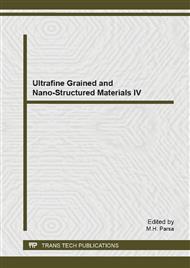[1]
O. Lupan, V.V. Ursaki, G. Chai, L. Chow, G.A. Emelchenko, Selective hydrogen gas nanosensor using individual ZnO nanowire with fast response at room temperature, Sens. Actuators, 144 (2010) 56–66.
DOI: 10.1016/j.snb.2009.10.038
Google Scholar
[2]
Z. L. Wang, ZnO nanowire and nanobelt platform for nanotechnology, Mater. Sci. Eng., 64 (2009) 33-71.
Google Scholar
[3]
A.B. Djurisi, A.M.C. Ng, X.Y. Chen, ZnO nanostructures for optoelectronics: Material properties and device applications, Prog. Mater Sci., 34 (2010) 191 – 259.
Google Scholar
[4]
Z. L. Wang, X. Doung, J. Zhou, Piezoelectric field effect transistor and nanoforce sensor based on a single ZnO nanowire, Nano Lett., 6 (2006) 2768–2772.
DOI: 10.1021/nl061802g
Google Scholar
[5]
Z. Fan, D. Wang, P.C. Chang, P.C. Chang, ZnO nanowire field-effect transistor and oxygen sensing property, Appl. Phys. Lett., 85 (2004) 5923-5927.
DOI: 10.1063/1.1836870
Google Scholar
[6]
J. Zhou, N.S. Xu, Z.L. Wang, Dissolving behavior and stability of ZnO wires in biofluids, Adv. Mater., 18 (2006) 2432–2435.
DOI: 10.1002/adma.200600200
Google Scholar
[7]
Y.J. Li, K.M. Li, C.Y. Wang, C.I. Kuo, L.J. Chen, Low-temperature electrodeposited Co-doped ZnO nanorods with enhanced ethanol and CO sensing properties, Sens. Actuators, 161 (2012) 734– 739.
DOI: 10.1016/j.snb.2011.11.024
Google Scholar
[8]
Y.L. Wang, A.Y. Ouslim, G.Y. Wang, Structure study of electrodeposited ZnO nanowires, Microelectron. J., 36 (2005) 625–628.
DOI: 10.1016/j.mejo.2005.04.033
Google Scholar
[9]
X.Y. Kong, L.W. Zhong, Polar-surface dominated ZnO nanobelts and the electrostatic energy induced nanohelixes, nanosprings, and nanospirals, Appl. Phys. Lett., 84 (2004) 975 – 977.
DOI: 10.1063/1.1646453
Google Scholar
[10]
D. Pradhan, S. Sindhwani, K.T. Leung, Parametric study on dimensional control of ZnO nanowalls and nanowires by electrochemical deposition, Nanoscale Res Lett., 5 (2010) 1727–1736.
DOI: 10.1007/s11671-010-9702-2
Google Scholar
[11]
C.X. Xu, X.W. Sun, Z.L. Dong, M.B. Yu, Self-organized nanocomb of ZnO fabricated by Au-catalyzed vapor-phase transport, Cryst. Growth, 270 (2004) 498–504.
DOI: 10.1016/j.jcrysgro.2004.07.010
Google Scholar
[12]
S. W Kim, S. Fujita, ZnO nanowires with high aspect ratios grown by metalorganic chemical vapor deposition using gold nanoparticles, Appl. Phys. Lett., 86 (2005) 159-162.
DOI: 10.1063/1.1883320
Google Scholar
[13]
M. Gupta, D. Pinisetty, J. C. Flake, J. J. Spivey, Pulse electrodeposition of Cu–ZnO and Mn–Cu–ZnO nanowires, Electrochem. Soc., 157 (2010) 473-478.
DOI: 10.1149/1.3456627
Google Scholar
[14]
J. Wang, L. Gao, Hydrothermal synthesis and photoluminescence properties of ZnO nanowires, Solid State Commun., 132 (2004) 269–271.
DOI: 10.1016/j.ssc.2004.07.052
Google Scholar
[15]
M.R. Khajavi, D.J. Blackwood, G. Cabanero, R. Tena-Zaera, New insight into growth mechanism of ZnO nanowires electrodeposited from nitrate-based solutions, Electrochim. Acta, 69 (2012) 181– 189.
DOI: 10.1016/j.electacta.2012.02.096
Google Scholar
[16]
S. Sun, S. Jiao, K. Zhang, D. Wang, S. Gao, H. Li, Nucleation effect and growth mechanism of ZnO nanostructures by electrodeposition from aqueous zinc nitrate baths, Journal of Cryst. Growth, 359 (2012) 15–19.
DOI: 10.1016/j.jcrysgro.2012.08.016
Google Scholar
[17]
S.K. Chakarvarti, Track-etch membranes enabled nano-/microtechnology: A review, Radiat. Meas., 44 (2009) 1085–1092.
DOI: 10.1016/j.radmeas.2009.10.028
Google Scholar
[18]
Y. Bahari, M. Ghorbani, A. Dolati, Electrodeposition of long gold nanotubes in polycarbonate templates as highly sensitive 3D nanoelectrode ensembles, Electrochim. Acta, 75 (2012) 157–163.
DOI: 10.1016/j.electacta.2012.04.119
Google Scholar
[19]
A. Goux, T. Pauport´, J. Chivot, D. Lincot, Temperature effects on ZnO electrodeposition, Electrochim. Acta, 50 (2005) 2239–2248.
DOI: 10.1016/j.electacta.2004.10.007
Google Scholar


